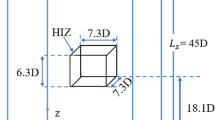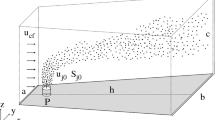Abstract
The inner structure of a two-phase plume, driven by air bubble buoyancy and formed in a stratification ambient fluid in a rectangular tank, is numerically simulated by means of two-phase flow theory and Large-eddy simulation technology. Focusing on the discrete nature of the buoyant dispersed phase and on the role of momentum exchange between two phases during plume formation, we investigated the phenomena of mass “entraining-in” and “peeling-out” that occurs inside the stratified ambient plume. These phenomena are thought to result from an intricate interplay among phase interaction, static stability of the stratification ambient fluid itself, and dynamic stability due to turbulence. Numerical simulations show that there exists an inner-out structure of the stratified ambient plume, while at the same time predicting that the re-entraining-in mass flux is on the same order of magnitude as that of the inner peeling-out mass flux within the annular region centered around the plume. This further explains the mechanism underlying the formation of multi-scale eddies at the edge of the air bubble plume, which also constitutes the boundary between the inner and outer zones of this inner-out stratified fluid plume. Within the inner part of the plume, the mass entraining-in and peeling-out appeared as a spatial discontinuity. The numerically visualized three-dimensional density fields are consistent with the two-phase plume characteristics.
Similar content being viewed by others
References
Asaeda, T. and Imberger, J., Structure of Bubble Plumes in Linearly Stratified Environments, J. Fluid. Mech. 249, (1993), 35–57.
Haungan, P. M., Thorkildsen, F. and Alendal, G., Dissolution of CO2 in the Ocean, Energy Convers. Mgmt. 36, (1995), 461–466.
Johansen. Ø., Deep Blow — a Lagrangian Plume Model for Deep Water Blowouts, Proceeding of 3rd International Marine Environmental Modeling Seminar, Lillebammer. (1999), 97–103.
Lesieur, M. and Métais, O., New Trends in Large-eddy Simulations of Turbulence, Annu. Rev. Fluid. Mech. 28, (1996), 45–87.
Liro, C. R., Adams, E. E. and Herzog, H. J., Modeling the Release of CO2 in the Deep Ocean, Energy Conserv. Mgmt. 33(5–8), (1992), 667–674.
Lam, K. and Banerjee, S., On the Condition of Streak Formation in a Bounded Turbulent Flow, Physics of Fluids A 4, (1992), 306–320.
McDougall, T. J., Bubble Plumes in Stratified Environments, J. Fluid Mech. 85, (1978), 655–672.
Schlodow, S. D., Bubble Plume Dynamics in a Stratified Medium and the Implications for Water Quality Amelioration in Lakes, Wat. Resour. Res. 28, (1992), 313–321.
Sirignano, W. A., The Formulation of Spray Combustion Models’ Resolution Compared to Droplet Spacing, ASME, J. of Heat Transfer, 108, (1986), 633–639.
Socolofsky, S. A, Laboratory Experiments of Multi-phase Plumes in Stratification and Cross Flow, Ph.D Thesis, Dept. of Civil and Environmental Eng, MIT, Cambridge, MA. U.S.A., (2000).
UNESCO, Tenth Report of the Joint Panel on Oceanographic Tables and Standards, UNESCO Technical Papers in Marine Science, 36, (1981), 24–29.
Van Doormaal, J. P. and Raithby, G. D., Enhancement of the SIMPLE Method for Predicting Incompressible Fluid Flows, Numer. Heat Transfer, 7, (1984), 147–163.
Author information
Authors and Affiliations
Corresponding author
Additional information
Baixin Chen: He received his Ph.D. degree in Mechanical Engineering in 1989 from Dalian University of Technology, then worked as an academic staff in the University till 1998 when he turned to work for Research Institute of Innovative Technology for the Earth (RITE), Japan. His research interests include the numerical simulation of turbulent multi-phase fl9ows in I.C. engines and Large-eddy simulation of environmental flow. He also interested in the optical diagnostics on physic-chemical properties of fluids and measurement technologies of CO2 hydrate clathrate formation and dissolution.
Yongchen Song: He received his MSc (Eng) and Ph.D. in Mechanical Engineering in 1989 and 1992 respectively from Dalian University of Technology. He then was pointed as an academic staff of the University till the year of 1996 when he began to work in Nagoya University and National Environmental Institute Japan as a researcher. Since year 2000, he had been worked for Research Institute of Innovative Technology for the Earth (RITE), Japan as a senior researcher. His research interests are the investigations of optical-based diagnostics on fluid follows and on physic-chemical properties and of CO2 sequestration technology.
Masahiro Nishio: He received his MSc (Eng) in Chemical Engineering in 1987 from Yokohama National University. He also received Ph.D. in Chemical Engineering in 1990 from Yokohama National University, then worked as a researcher for Mechanical Engineering Laboratory, AIST, MITI. He has been working in the National Institute of Advanced Industrial Science and Technology (AIST) Tsukuba as a senior research scientist. His research interests are CO2 sequestration technology, Crystal Growth of Gas Hydrate and Flow Visualization.
Satoshi Someya: He received his Ph.D. degree in Nuclear Engineering in 1998 from University of Tokyo, then worked as a Research Fellow of New Energy and Industrial Technology Development Organization (NEDO) (1998–2000) in the Mechanical Engineering Laboratory of AIST. He has worked in National Institute of Advanced Industrial Science and Technology (AIST) Tsukuba as a temporary researcher. He is a member of Thermal Engineering Research Group. His research interests are Crystal Growth, CO2 sequestration, Flow Induced Vibration and Flow Visualization.
Rights and permissions
About this article
Cite this article
Chen, B., Song, Y., Nishio, M. et al. Numerical simulation of the inner structure of a two-phase plume formed in a stratification environment. J Vis 6, 9–20 (2003). https://doi.org/10.1007/BF03180960
Received:
Revised:
Issue Date:
DOI: https://doi.org/10.1007/BF03180960




